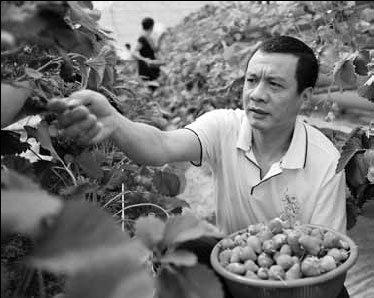
|
Hydroponically cultivated strawberries are harvested inShangjie, a village in Lingchuan county, the GuangxiZhuang autonomous region, in April. Scientific andtechnological authorities in Guangxi used a special 1.5million yuan ($245,000) fund to support hydroculture in thevillage after a water shortage. Photo by Lu Boan / Xinhua For Bai Qiangguo, 53, life on the wind-blown plains of central NingxiaHui autonomous region was like being frozen in time: the use ofexcessive pesticides and fertilizers to farm the reluctant land took itstoll on the little fertility there is in the soil. The land became sandierand sandier, increasingly prone to dust storms. But science is bringing the cycle to an end and giving farmers aharvest for the future. "Now I work on the land during the day, and use the Internet to sellmy wolfberries in the evening," Bai Qiangguo said. "I never thought Iwould have anything to do with high technology." Bai and the other farmers who benefited from wolfberry plantingtechnology in Ningxia are only a part of a much more ambitious planof the government to boost agriculture through technology. "If we bring technology into agriculture in the Ningxia Hui autonomousregion, one of the country's poorest rural regions, we can do it in anyregion in China," Zhang Laiwu, vice-minister of science and technology, told China Daily. This does not mean just adding new technology into crop planting, or to replacing labor withmachines. Instead, it is a more complex systematic reform: farmers working in commercialized farms, usinghigh-tech equipment to improve both production and quality of the crop. On top of this, theentire community will benefit through the processing industry, logistics, and financial servicessystem. The result will be that skilled talent will be attracted to agriculture. "The essential factors in traditional agriculture include land, natural resources, like water andlabor. But now we will integrate new productive factors like technology, modern managementtheory and social services," he said. Although the methods of industrial agriculture, such as techniques for achieving economies ofscale in production, are common in developed economies and increasingly prevalentworldwide, China's agriculture remained "old-fashioned", Zhang said. According to the National Bureau of Statistics, the per capita disposable income of urbanresidents was 21,810 yuan ($3,520) in 2011, three times the rural per capita income of 6,977yuan in the same year. "The gap is much larger than the global average," Zhang said. To make things worse, more and more farmers are leaving their land for the cities, causinglabor shortages in rural areas. In 2012, China had 262.61 million migrant workers, according tothe bureau. "The most important thing is to train farmers who are capable of making money fromagriculture," Zhang said. Between 2009 and 2012, the ministry sent 240,800 science and technology specialists to ruralregions. Zhang Shengming, 48, was one. In 2007, Zhang contracted 13.3 hectares of land in Ningxia for wolfberry plating. He found that pesticide and fertilizer abuse was common. Zhang established a group of farmers who set strict restrictions on the use of pesticide andfertilizers. It soon attracted 537 households. By 2012, the number of households planting wolfberries in the town had increased from 80 (in2007) to 1,050, producing a yearly income of 6,350 yuan per person. The specialists, distributed in 31 provinces, municipalities and autonomous regions, set up8,401 agriculture-related businesses by the end of 2011, covering 57.56 million people in ruralareas. They managed to achieve 2.68 billion yuan in profit, according to the Ministry of Science andTechnology. Zhang also launched projects to build agricultural science and technology parks nationwide. Since 2001, 73 agricultural science and technology parks have been built, and these help trainfarmers in the most modern and productive methods of farming. "The parks are like the headquarters of our agriculture industry - they combine each link on theindustrial chain, from R&D to products, and cultivate more agricultural talent for us," Zhangsaid. The National Agricultural Science and Technology Zone of the Yellow River Delta (Bin Zhou),located in Shandong province, is an example for the integration of technology and agriculture. In April, four digital "jackstraws" were installed on an experimental plot in the zone. The"jackstraw", a robot based on the Internet of Things technology, inspects the status of cropsand sends the information back to the user's cellphone. "This means you can sit in your couch and farm the field via your cellphone," Zhang said. |
对于53岁的白强国来说,时间似乎凝固在宁夏平原上:农民们为了勉强度日,在本就贫瘠的土地上施用大量的农药和化肥,年复一年,这种耕种方式又反过来使得土地更加贫瘠。 直到十年前,这里生活的人们还一代代地重复着这样低效率的劳作,直到科学的枸杞种植技术和严格的用药制度传到了这里,使村民的生活出现了新的改变。 “现在我白天在田里种地,晚上回家上网销售我地里的枸杞,”白强国说,“原来我从没想过,我还能和高科技的东西沾边。但是现在我却每天都在应用互联网,这真是太奇妙了!” 然而,不仅是白强国,甚至包括宁夏所有像他一样享受到科学种植技术的好处的农民,都仅仅是我国实现现代农业全盘计划中的一小部分。 “既然我们能把现代农业带到宁夏,那么全国还有什么地方是我们做不到的吗?”中华人民共和国科学技术部副部长张来武在接受中国日报专访的时候说。 在张来武眼中,现代农业可不仅仅是在作物培育中应用新技术,或是以机械代替人工劳动那么简单。相反,现代农业“不是传统的第一产业概念,而是以现代服务业引领的一、二、三产业的有机结合体,”张来武说。 “不仅做一产,还要做二产、还要做三产,用现代服务业引领现代农业。原来有微笑曲线的两端,高附加值的两端在背后,这边抓产品研发,这边抓市场品牌,现代物流配送,找金融,市场信息手段,都是微笑曲线的两端,干了就赚钱,”他说。 张来武强调,随着从传统农业向现代农业的快速转型,农业的核心要素将由土地、水等自然资源,转变为科技进步和人力资本;是以科技等现代生产要素的综合投入为基础,以现代物质条件、工业化生产手段和先进科学技术为支撑,以社会化的服务体系相配套,用现代经营方式和组织形式进行管理的“产业化大农业”。 农业的产业化,在世界范围内,是随着18世纪末英国工业革命而诞生的。在产业化农业中,无论是农作物还是牲畜、家禽、渔业,都以工业化的方式生产和销售。同时,产业化农业还拥有一系列的辅助手段,比如形成规模效应的经济工具等。 “改革开放30多年来,我国农业、农村发展取得了举世瞩目的成就。但由于历史原因,农村发展滞后于城市的状况仍然没有得到根本改变,城乡二元结构依然存在,城乡发展差距仍在扩大,”张来武说。 据国家统计局发布的数据,2011年城镇居民人均可支配收入(21,810元)是农村居民人均纯收入(6,977元)的3倍多,远高于世界平均水平。“未来30年,我国面临的最大挑战就是如何破解城乡二元结构,”张来武说。 随着城乡二元结构的差距不断扩大,越来越多的农业人口离开自己的土地,到城镇里生活,造成了农村地区的相对劳动力短缺。据统计,2012年我国已经有26261万农民工。 “传统农业是以小生产为特征的‘小农经济’,以原材料和低端加工为主,科技含量少、规模小、商品率低。只有用现代经营方式和组织形式进行管理的‘大农业’,才能贯穿了第一、第二、第三产业,形成较高的利润率,”张来武说。 要搞现代农业,首先就要有人,有专业从事农业的职业农民,而科技部、农业部、教育部等九个部委一起抓的农村科技特派员项目就为中国培养了第一批职业农民。 截至2011年底,全国科技特派员队伍已达24.08万人,法人科技特派员7298家,比上一年增长了57%。 张生明就是全国24万科技特派员中的一名。2007年宁夏回族自治区西夏区政府将团结村确定为万亩有机枸杞种植基地,张生明承包种植精品园200亩,发挥有机枸杞种植的示范作用,带动了全镇万亩有机枸杞生产的发展,为农民增收打下坚实的基础。张生明发现,当地枸杞种植户较为分散,且过量施用农药和化肥的情况非常普遍。于是,在张生明的大力倡导下,组织村民自发成立了枸杞种植专业合作社,主要从枸杞种植、收购、储藏、加工、销售、新技术推广、咨询服务等方面进行管理,吸引了537名社员。 通过提高枸杞的品质,使得枸杞的售价大幅提高,全镇枸杞种植户由过去的80多户发展到现在的1050户,其中团结村537户,种植面积达到5000余亩,直接经济效益年产值2600万元,净利润1800万元。直接受益人数2400余人,间接受益人数6780人,枸杞收入占农民人均收入的70℅,年节约成本资金220多万元。农民人均纯收入从2006年的1758元提高到2012年的6350元。 “这是我们农村特派员的一个好例子,现代农业需要培养职业农民。改造传统农业,提高劳动生产率,最直接、最有效的途径就是依靠科技提高劳动者综合素质,培养一批职业化的现代农业大军,”张来武说。 截止2011年底,全国有31个省(区市)开展了科技特派员农村创业工作,组建利益共同体1.6万个,创办企业8401家,其中龙头企业2642家,实施科技开发项目2.48万项,直接参与农户446万户,辐射带动农民5756万,创业获利26.8亿元。 此外,国家还大力推进国家农业科技园区建设,带动不同区域现代农业产业发展。2001年科技部会同农业部、水利部、国家林业局、中国科学院、中国农业银行等开始国家农业科技园区建设。截止目前,全国已经建立了73个国家农业科技园区。2012年全国农业科技园区核心区建成面积300多万亩,园区各类融资总额达到1880多亿元,入住园区企业总数6218家。园区实现年产值近3000亿元,组织科普讲座培训工作超过1万次,转化科技成果近1000项,受益农民100多万人。 “我们要把这种园区作为一个抓手,使得我们的服务基地,信息化总部,产业链的聚集,企业家的培育都在这里产生着聚集效益,”张来武说。 比如,黄河三角洲(滨州)国家农业科技园区就为市场运作、成果转化上搭建了良好的平台。今年4月,在无棣县柳堡镇“渤海粮仓”核心试验区内,与风力发电相类似的四座设备坐落其中,它被称作“智慧稻草人”。这些“稻草人”通过物联网技术实现对农作物生长环境综合信息进行智能监测,是集农作物种植环境信息数据采集、存储、传输和管理于一体的无人值守的农业综合信息智能监测系统。 “有了这些智慧稻草人,未来的农民只需要坐在自己家里的沙发上,通过手机监控,就可以知道田地里作物的情况了,”张来武说。 “既然我们说,农业现代化是系统设计,那么,科技部当然是承担这个系统设计的主管部门,维护这个系统,支持这个系统的政策制订部门,”张来武说。 “我们将利用国家的资源,科技计划,政策资源,去发现,去支持企业家们,甚至于职业农民们在市场竞争中产生的创造。这种创造加以协调,加以认可,加以推广,加以发扬光大,这是最重要的使命。要谦虚的走进市场一线,走进职业农民中间,去看看我们能为他们做点什么。” (中国日报记者程盈琪编译) |